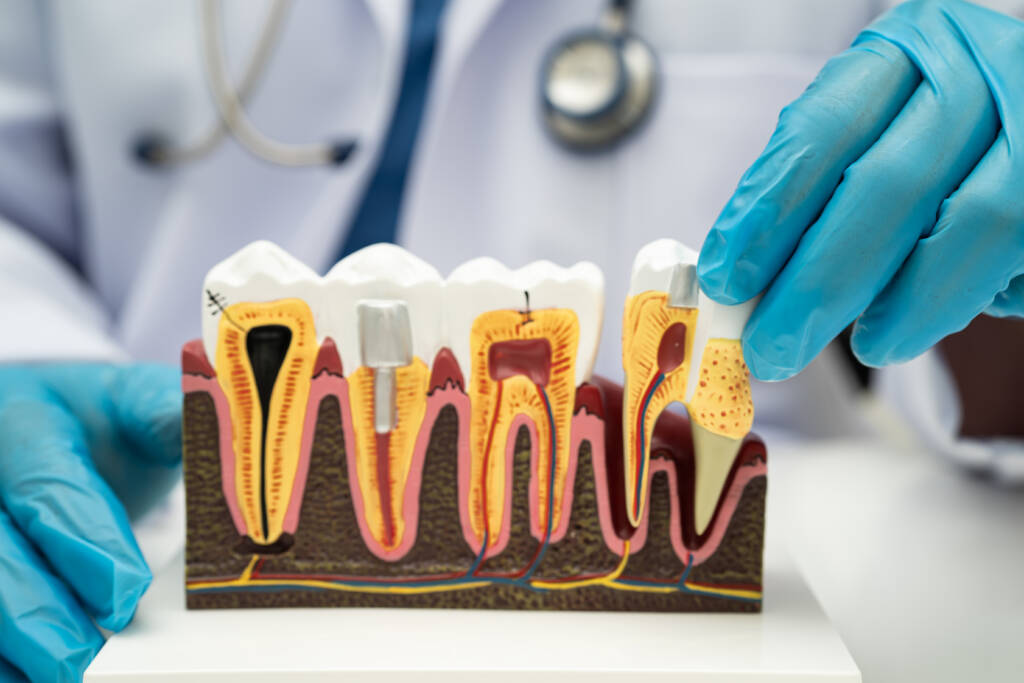
Periodontal diseases are inflammatory diseases that affect the gums and other tissues that support the teeth. Periodontal disease is responsible for 70% of tooth loss in adults.
When diagnosed early, these diseases can be easily and successfully treated. Preventing or treating gum disease also offers other benefits, such as preserving natural teeth, providing easier chewing, and improving digestion. Periodontal disease begins with gingivitis. Gingivitis is the early stage of periodontal disease. During this stage, the gums bleed, become red, and enlarge in size. It may not cause much discomfort in the early stages. If left untreated, the disease can progress to periodontitis, causing irreversible damage to the alveolar bone that supports the gums and teeth. Periodontitis is a more advanced stage of periodontal disease. Along with other tissues that support the teeth, the alveolar bone also suffers damage. A “periodontal pocket” forms between the tooth and the gum. The presence of a periodontal pocket facilitates the localization of infection and the progression of the disease. As the disease progresses, teeth begin to loosen and may even need to be extracted.
What are the symptoms of gum disease?
Gum disease has many symptoms, including: Bleeding gums during tooth brushing, Red, swollen, and tender gums, Receding gums that can easily separate from the teeth, Inflammatory discharge between the teeth and gums, Loose or increasingly distant teeth (gaps), Changes in the relationship between the upper and lower teeth during biting, Partial changes in the fit of dentures, Persistent bad breath. However, periodontal disease can progress to advanced stages without any symptoms. Therefore, regular visits to the dentist are extremely important.
What causes gum disease?
The most significant cause of gum disease is the sticky, colorless film called “bacterial dental plaque” that accumulates on the teeth. Removing plaque through daily brushing and flossing is essential for a healthy mouth. If plaque is not effectively removed from the teeth, it transforms into an irregular and permeable substance known as calculus or tartar. Harmful products secreted by the bacteria in plaque cause irritation to the gums. These products damage the fibers that firmly attach the gum to the tooth, pulling the gum away from the tooth, and forming a periodontal pocket. This facilitates the migration of bacteria and their products into deeper tissues. As the disease progresses, the pocket deepens, and bacteria move deeper into the bone, causing destruction of the alveolar bone supporting the tooth. If the disease is left untreated, teeth may become loose over time and may even need to be extracted.
How can gum disease be prevented?
The most important role in preventing periodontal disease rests with the individual. To maintain healthy teeth, it is necessary to remove bacterial plaque through daily oral care procedures (brushing and flossing). Regular visits to the dentist are equally important. Daily oral care procedures can minimize, but may not prevent, tartar buildup completely. To remove existing plaque and/or tartar, areas that a toothbrush, floss, or other cleaning tools cannot reach should be evaluated by a dentist.
What is the treatment for gum disease?
Treatment of gum disease in the early stages involves removing plaque and tartar from the teeth and ensuring a smooth root surface. This process removes bacteria and irritants that cause inflammation in the gums. This treatment is usually sufficient to allow the gums to reattach to the teeth or to shrink the gums, eliminating the pocket. In most cases of early-stage gum disease, scaling, plaque removal, and achieving a smooth root surface, followed by daily effective oral care, are sufficient for successful treatment. In more advanced cases, surgical treatment may be necessary. The goal of this treatment is to remove tartar from the deep periodontal pockets surrounding the teeth, reduce and eliminate the pockets, create a smooth root surface, and create a more easily cleanable gum structure. After periodontal treatment, patients should be examined regularly by a dentist, check for plaque, and remove any new tartar buildup. However, it is important to remember that no procedure is more beneficial for maintaining the success achieved with periodontal treatment than the effective implementation of daily oral care procedures.

